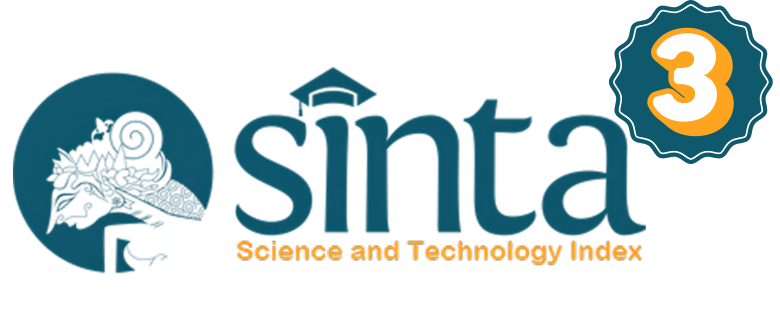Tanmiyah Mahârah al-Kalâm bi Tathbîqi at-Tharîqah al-Ittishâliyyah: al-Bahts at-Tanfîdziy fî al-Fiah ad-Dirâsiyyah
 Abstract views: 1774
,
Abstract views: 1774
,
 pdf downloads: 608
pdf downloads: 608
Abstract
This research was intended to improve student's speaking ability by applying communicative method, and at the same time, to find out the effectiveness of using this teaching method in promoting speaking skills. The problem with this research was formulated interrogatively as follows: Is the implementation of communicative methods capable of improving the speaking skills of eighth grade students at National Islamic Junior School, Bandar Lampung? This research can be categorized as Classroom Action Research, and as subject research. They are all eight grade students at National Islamic Junior School Bandar Lampung. To obtain data, this research used several methods: observation, interview, documentation, and testing. This research is qualitative research, and the data was analyzed in three steps: data reduction, data display, and then interpretation. This research results in the following conclusions: In first session, the students who passed the test 54.40% and who failed 45.59%, in second session, students who passed the test 86.64%, and who failed 13.35%, and in the third session the students who passed test 78.83%, and who failed 21.16%, than can be concluded that implementing a communicative method in teaching Arabic as a second language is capable of improving speaking skills.
Downloads
References
ديوي حميدة، منهج اللغة العربية للمدارس الإسلامية من الطراز العالمي. مالانج: UIN-MALIKI Press، .2011
سلطان شهريل، طرائق تدريس اللغة العربية بين النظرية والتطبيق. باندار لامبونج: كلية التربية والتعليم جامعة رادين إينتان، 2007.
عبد الرحمن البدوي، مناهج البحث العلمي الطبعة الثالثة. الكويت: الناشر وكالة المطبوعا شارع فهد السالم، 1977.
رمضان محمد البدري، المعجم العصري للمصطلحات الدينية عربي فرنسي. شارع الملك فيصل- الهرم: الدار العالمية للنشر والتوزيع، 2004.
Arikunto, Suharsimi, Suhardjono, Supardi. Penelitian Tindakan Kelas. Jakarta: Bumi Aksara, 2014.
. Dasar-Dasar Evaluasi Pendidikan, Jakarta: Bumi Aksara, Edisi Kedua, Cetakan kedua, 2013.
. Prosedur Penelitian Suatu Pendekatan Praktik. Jakarta: Rineka Cipta, 2006.
. Prosedur Penelitian Suatu Pendekatan Praktik. Yogyakarta: Rineka Cipta, 2006.
. Prosedur Penelitian, Jakarta: Bina Aksara, 1998.
Arsyad, Azhar. Bahasa Arab dan Metode Pengajarannya: Beberapa Pokok Pikiran, Cet. Ke-3. Yogyakarta: Pustaka
Pelajar, 2010.
Effendy, Ahmad Fuad. Metodologi Pengajaran Bahasa Arab. Malang: Misykat, 2012.
Fachurrozi, Aziz dan Erta Mahyuddin. Pembelajaran Bahasa Asing Metode Tradisional dan Kontemporer. Jakarta: Bania Publishing, 2011.
Hasanova, Dilbarhon and Tatyana Shadieva. “Implementing Communicative Language Teaching in Uzbekistan”, TESOL Quarterly. Vol. 42, No. 1, 2008.
Kaelan. Metode Penelitian Kualitatif Interdisipliner. Yogyakarta: Paradigma, 2012.
Kartono. Kartini Pengantar Metodologi Riset Sosial. Bandung: Mandar Maju, 1996.
Kunandar. Langkah Mudah Penelitian Tindakan Kelas Sebagai Pengembangan Profesi Guru. Jakarta: Raja Grafindo, 2011.
Muchsinul Khuluq dan Siti Zulaikha. “Tadakhkhulu al-Lughatu al-Umm fî Mahârati al-Kalâm bimarkazi al-Lughah al-'Arabiyah fî Ma'hadi al-'Inâyah Sumber Batu lilbanât Pegantenan Pamekasan”, Alibbaa’: Jurnal Pendidikan Bahasa Arab, Vol. 1, No. 1, 2020.
Muradi, Ahmad. “Pendekatan Komunikatif dalam Pembelajaran Bahasa Arab”, Arabiyat: Jurnal Pendidikan Bahasa Arab dan Kebahasaaraban, Vol. I, No. 1, Juni 2014.
Mustofa, Syaiful. Strategi Pembelajaran Bahasa Arab Inovativ. Malang: UIN Maliki Press, 2011.
Nuha, Ulin. Metodologi Super Efektif Pembelajaran Bahasa Arab. Yogyakarta: DIVA Press, 2012.
Richards, Jack C. Communicative Language Teaching Today. New York: Cambridge University Press, 2006.
Ritchie, Jane and Jane Lewis, Qualitative Research Practice a Guide for Social Science Students and Researchers. London: SAGE Publications, 2003.
Sato, Kazuyoshi and Robert C. Kleinsasser. “Communicative Language Teaching (CLT): Practical Understandings”, The Modern Language Journal, Vol. 83, No. 4 Winter, 1999.
Satori, Djam’an dan Aan Komariah. Metodologi Penelitian Kualitatif. Bandung: Alfabeta, 2013.
Savignon, Sandra J. “Communicative Language Teaching, Theory into Practice”, Teaching Foreign Languages, Vol. 26, No. 4, 1987.
Sudjana, Nana. Penilaian Hasil Proses Belajar Mengajar. Bandung: Remaja Rosda Karya, 2000.
Wehr, Hans. A Dictionary of Modern Written Arabic third edition. New York: Spoken Language Service.Inc, 1976.
Yu, Liming. “Communicative Language Teaching in China: Progress and Resistance”, TESOL Quarterly, Vol. 35, No. 1, 2001.
Authors who publish with this journal agree to the following terms:
a. Authors retain copyright and grant the journal right of first publication with the work simultaneously licensed under a Creative Commons Attribution License that allows others to share the work with an acknowledgement of the work's authorship and initial publication in this journal.
b. Authors are able to enter into separate, additional contractual arrangements for the non-exclusive distribution of the journal's published version of the work (e.g., post it to an institutional repository or publish it in a book), with an acknowledgement of its initial publication in this journal.
c. Authors are permitted and encouraged to post their work online (e.g., in institutional repositories or on their website) prior to and during the submission process, as it can lead to productive exchanges, as well as earlier and greater citation of published work (See The Effect of Open Access).
Alibbaa': Jurnal Pendidikan Bahasa Arab have CC-BY-SA or an equivalent license as the optimal license for the publication, distribution, use, and reuse of scholarly work.
In developing strategy and setting priorities, Alibbaa': Jurnal Pendidikan Bahasa Arab recognize that free access is better than priced access, libre access is better than free access, and libre under CC-BY-SA or the equivalent is better than libre under more restrictive open licenses. We should achieve what we can when we can. We should not delay achieving free in order to achieve libre, and we should not stop with free when we can achieve libre.

Alibbaa': Jurnal Pendidikan Bahasa Arab is licensed under a Creative Commons Attribution 4.0 International License
You are free to:
- Share — copy and redistribute the material in any medium or format
- Adapt — remix, transform, and build upon the material for any purpose, even commercially.
- The licensor cannot revoke these freedoms as long as you follow the license terms.











